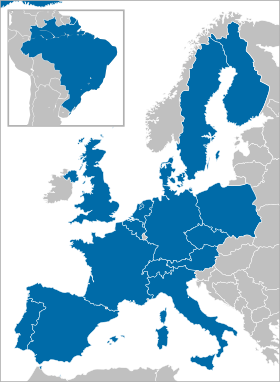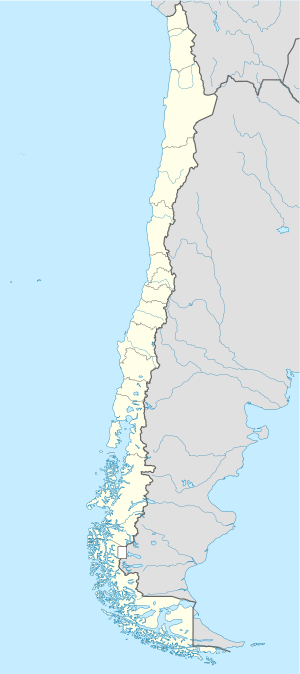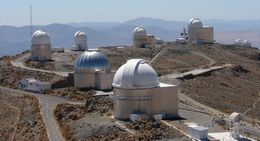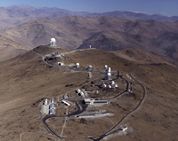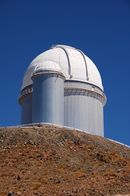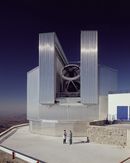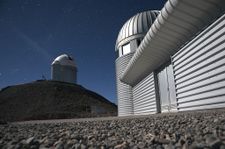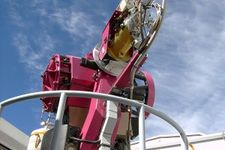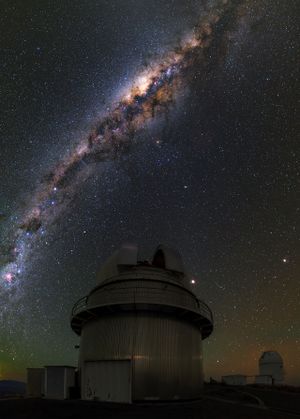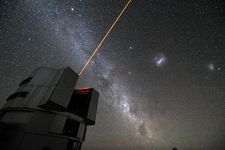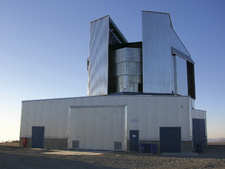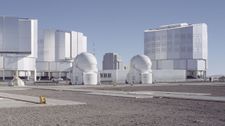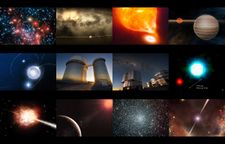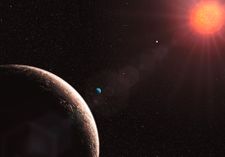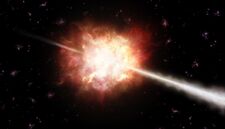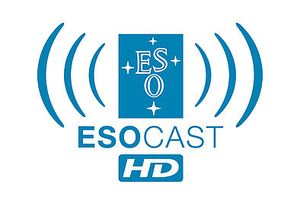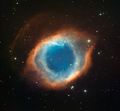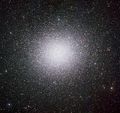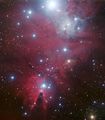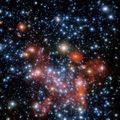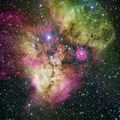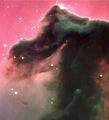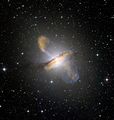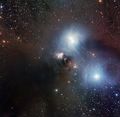المرصد الجنوبي الأوروپي
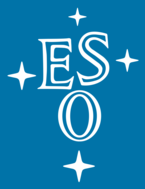 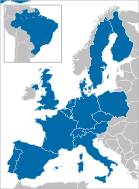 شعار ESO وخريطة الدول المشاركة | |
| التشكل | 1962 |
|---|---|
| النوع | منظمة دولية |
| الغرض | منظمة أبحاث في الفلك |
| المقر الرئيسي | Garching، ألمانيا |
الأعضاء | 16 (15 بلد أوروپي والبرازيل) |
اللغة الرسمية | الألمانية والإنگليزية والاسبانية والإيطالية والبولندية والبرتغالية والتشيكية، الدنماركية والسويدية والفرنسية والفنلندية |
المدير العام | Tim de Zeeuw |
| الموقع الإلكتروني | ESO.org |
المرصد الجنوبي الأوروپي European Southern Observatory (ESO، وسابقاً: المنظمة الأوروبية للأبحاث الفلكية في نصف الكرة الجنوبي؛ فرنسية: Organisation Européenne pour des Recherches Astronomiques dans l'Hémisphere Austral) هو منظمة أبحاث دولية من 16 دولة for ground-based astronomy. Created in 1962, ESO has provided astronomers with state-of-the-art research facilities and access to the southern sky. The organisation employs about 730 staff members and receives annual member state contributions of approximately €131 million.[1] Its observatories are located in northern Chile.
ESO has built and operated some of the largest and most technologically advanced telescopes. These include the New Technology Telescope, an early pioneer in the use of active optics, and the Very Large Telescope (VLT), which consists of four individual telescopes, each with a primary mirror 8.2 metre across, and four smaller auxiliary telescopes. The Atacama Large Millimeter Array observes the universe in the millimetre and submillimetre wavelength ranges, and is the world's largest ground-based astronomy project to date. It was completed in March 2013 in an international collaboration by Europe (represented by ESO), North America, East Asia and Chile.[2][3]
Currently under construction is the European Extremely Large Telescope. It will use a 39.3-metre-diameter segmented mirror, and become the world's largest optical reflecting telescope when operational in 2024. Its light-gathering power will allow detailed studies of planets around other stars, the first objects in the universe, supermassive black holes, and the nature and distribution of the dark matter and dark energy which dominate the universe.
ESO's observing facilities have made astronomical discoveries and produced several astronomical catalogues.[4] Its findings include the discovery of the most distant gamma-ray burst and evidence for a black hole at the centre of the Milky Way.[5][6] In 2004, the VLT allowed astronomers to obtain the first picture of an extrasolar planet (2M1207b) orbiting a brown dwarf 173 light-years away.[7] The High Accuracy Radial Velocity Planet Searcher (HARPS) instrument installed in another ESO telescope led to the discovery of extrasolar planets, including Gliese 581 c—one of the smallest planets seen outside the solar system.[8]
التاريخ
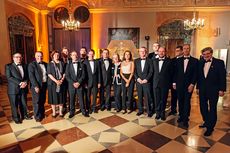
| المديرون العموم للـ ESO | |
|---|---|
| Otto Heckmann | 1962–1969 |
| Adriaan Blaauw | 1970–1974 |
| Lodewijk Woltjer | 1975–1987 |
| Harry van der Laan | 1988–1992 |
| Riccardo Giacconi | 1993–1999 |
| Catherine Cesarsky | 1999–2007 |
| Tim de Zeeuw | 2007–present |
| المصدر: www.eso.org, about ESO[10] | |
الدول الأعضاء
| البلد | تاريخ الانضمام[12] |
|---|---|
| 1962 | |
| 1962 | |
| 1962 | |
| 1962 | |
| 1962 | |
| 1967 | |
| 1981 | |
| 24 مايو 1982 | |
| 27 يونيو 2000 | |
| 8 July 2002 | |
| 1 يوليو 2004 | |
| 1 July 2006 | |
| 1 يناير 2007 | |
| 1 يوليو 2008 | |
| 29 ديسمبر 2010 (لم يتم بعد) | |
| 28 أكتوبر 2014 |
مواقع الرصد التشيلية
| تلسكوبات ESO | |||||||
|---|---|---|---|---|---|---|---|
| الاسم | المختصر | Size | النوع | الموقع | السنة | ||
| ESO 3.6 m telescope – hosting HARPS | ESO 3.6m | 3.57 m | optical and infrared | لا سيا | 1977 | ||
| MPG/ESO 2.2 m telescope | MPG | 2.20 m | optical and infrared | لا سيا | 1984 | ||
| New Technology Telescope | NTT | 3.58 m | optical and infrared | لا سيا | 1989 | ||
| Very Large Telescope | VLT | 4 × 8.2 m 4 × 1.8 m |
optical to mid-infrared, array | پارانال | 1998 | ||
| Atacama Pathfinder Experiment | APEX | 12 m | millimetre-/submillimetre-wavelength | تشاخناتور | 2005 | ||
| Visible and Infrared Survey Telescope for Astronomy | VISTA | 4.1 m | near-infrared, survey | پارانال | 2009 | ||
| VLT Survey Telescope | VST | 2.6 m | optical, survey | پارانال | 2011 | ||
| Atacama Large Millimeter/submillimeter Array[A] | ALMA | 50 × 12 m 12 × 7 m 4 × 12 m[15] |
millimetre-/submillimetre-wavelength interferometer array |
Chajnantor | 2011 | ||
| European Extremely Large Telescope | E-ELT | 39.3 m | optical to mid-infrared | Cerro Armazones[16] | 2024 | ||
| A ALMA is a partnership among Europe, the United States, Canada, East Asia and the Republic of Chile. • Additional ESO research facilities are located in Santiago, Chile and include a library, computing resources and programmes for visiting scientists.[17] • ESO also maintains close ties with other observatories and universities throughout the country.[18][19] • Source: ESO – Telescopes and Instrumentation[20] | |||||||
لا سيا
ESO 3.6-metre telescope
MPG/ESO 2.2-metre telescope
التلسكوبات الأخرى
La Silla also hosts several national and project telescopes not operated by ESO. Among them are the Swiss Euler Telescope, the Danish National Telescope and the REM, TRAPPIST and TAROT telescopes.[21]
- The Euler Telescope is a 1.2-metre telescope built and operated by the Geneva Observatory in Switzerland. It is used to conduct high-precision radial velocity measurements primarily used in the search for large extrasolar planets in the southern celestial hemisphere. Its first discovery was a planet orbiting Gliese 86.[22] Other observing programmes focus on variable stars, asteroseismology, gamma-ray bursts, monitoring active galactic nuclei (AGN) and gravitational lenses.[23]
- The 1.54-metre Danish National Telescope was built by Grubb-Parsons and has been in use at La Silla since 1979. The telescope has an off-axis mount, and the optics are a Ritchey-Chrétien design. Because of the telescope's mount and limited space inside the dome, it has significant pointing restrictions.[24]
- The Rapid Eye Mount telescope is a small rapid-reaction automatic telescope with a primary 60-سنتيمتر (24 in) mirror. The telescope, in an altazimuth mount, began operation in October 2002. The primary purpose of the telescope is to follow the afterglow of the GRBs detected by the Swift Gamma-Ray Burst Mission satellite.[21][26]
- The Belgian TRAPPIST is a joint venture between the University of Liège and Geneva Observatory. The 0.60-metre telescope is specialized in comets, exoplanets, and was one of the few telescopes that observed a stellar occultation of the dwarf planet Eris, revealing that it may be smaller than Pluto.[27]
- The Quick-action telescope for transient objects, TAROT, is a very fast-moving optical robotic telescope able to observe a gamma-ray burst from its beginning. Satellites detecting GRBs send signals to TAROT, which can provide a sub-arc second position to the astronomical community. Data from the TAROT telescope is also useful in studying the evolution of GRBs, the physics of a fireball and its surrounding material.[28] It is operated from the Haute-Provence Observatory in France.
Paranal
The Paranal Observatory is located atop Cerro Paranal in the Atacama Desert in northern Chile. Cerro Paranal is a 2،635-متر-high (8،645 ft) mountain about 120 كيلومتر (75 mi) south of Antofagasta and 12 كيلومتر (7.5 mi) from the Pacific coast.[29]
The observatory has seven major telescopes operating in visible and infrared light: the four 8.2-متر (27 ft) telescopes of the Very Large Telescope, the 2.6-متر (8 ft 6 in) VLT Survey Telescope (VST) and the 4.1-متر (13 ft) Visible and Infrared Survey Telescope for Astronomy. In addition, there are four 1.8-متر (5 ft 11 in) auxiliary telescopes forming an array used for interferometric observations.[30] In March 2008, Paranal was the location for several scenes of the 22nd James Bond film, Quantum of Solace.[31][32]
التلسكوب الكبير جداً
تلسكوبات المسح
الاكتشافات الكبرى
التواصل مع الجمهور
المطبوعات
معرض فيديوهات
ESO's 50th-anniversary event (Munich Residenz in Germany, 11 October 2012)
ESO's first 50 years of exploring the southern sky
José Manuel Barroso visits the ESO in January 2013.
Tim de Zeeuw talks on ESO and its 50th Anniversary.
The temporary office buildings at the ESO Headquarters in Garching being dismantled.
Timelapses of ESO's VLT, ALMA and La Silla site
معرض صور
هذه مختارات من قائمة أفضل مائة صورة التقطها ESO.
انظر أيضاً
- Cerro Tololo Inter-American Observatory, U.S. main site in Chile
- European Extremely Large Telescope, ESO's largest telescope under construction
- European Northern Observatory
- Roque de los Muchachos Observatory, telescopes on the Canary Islands, Spain
- Teide Observatory, telescopes on the Canary Islands, Spain
References
- ^ "About ESO". 2012-04-02. Retrieved 2015-01-02.
- ^ "ALMA website". Retrieved 2011-09-21.
- ^ "Welcome to ALMA!". Retrieved 2011-05-25.
- ^ "ESO Archive". Retrieved 2011-04-28.
- ^ "A gamma-ray burst at a redshift of 8.2". Retrieved 2011-09-21.
- ^ Gillessen, S.; Eisenhauer, F.; Trippe, S.; Alexander, T.; et al. (1970). "Monitoring stellar orbits around the Massive Black Hole in the Galactic Center". The Astrophysical Journal. 692 (2): 1075. arXiv:0810.4674. Bibcode:2009ApJ...692.1075G. doi:10.1088/0004-637X/692/2/1075.
- ^ Chauvin, G.; Lagrange, A.-M.; Dumas, C.; Zuckerman, B.; et al. (2004). "A giant planet candidate near a young brown dwarf. Direct VLT/NACO observations using IR wavefront sensing". Astronomy and Astrophysics. 425 (2): L29. arXiv:astro-ph/0409323. Bibcode:2004A&A...425L..29C. doi:10.1051/0004-6361:200400056.
- ^ "The HARPS Home page". Retrieved 2011-09-21.
- ^ "Gala Event Celebrates 50 Years of the European Southern Observatory". ESO Press Release. Retrieved 14 October 2012.
- ^ "Past ESO Directors General". Retrieved 2011-04-29.
- ^ "ESO Expands its Headquarters". ESO Press Release. Retrieved 13 April 2012.
- ^ http://www.eso.org/public/about-eso/memberstates/
- ^ "A Timeless Sanctuary in Santiago — The ESO Guesthouse, Then and Now". ESO Picture of the Week. Retrieved 13 February 2013.
- ^ "Fernando Comerón becomes ESO Representative in Chile". ESO. Retrieved 4 April 2013.
- ^ Satoru Iguchi; Morita, Koh-Ichiro; Sugimoto, Masahiro; Vila Vilaró, Baltasar; Saito, Masao; Hasegawa, Tetsuo; Kawabe, Ryohei; Tatematsu, Ken'Ichi; Seiichi, Seiichi; et al. (2009). "The Atacama Compact Array (ACA)". Publ. Astron. Soc. Japan. 61: 1–12. Bibcode:2009PASJ...61....1I. doi:10.1093/pasj/61.1.1. Retrieved 2011-04-29.
- ^ خطأ استشهاد: وسم
<ref>غير صحيح؛ لا نص تم توفيره للمراجع المسماةThe E-ELT project - ^ "Science in Santiago". Retrieved 2011-10-04.
- ^ "Minutes of the ESO Chile Joint Committee" (PDF). Retrieved 2011-10-05.
- ^ "Cooperative Projects in Chile". Retrieved 2011-10-05.
- ^ "Telescopes and Instrumentation". Retrieved 2011-04-29.
- ^ أ ب "National and Project Telescopes". Retrieved 2011-04-29.
- ^ "Extrasolar Planet in Double Star System Discovered from La Silla". ESO. 24 November 1998. Retrieved 2011-04-29.
- ^ "Southern Sky extrasolar Planet search Programme". Retrieved 2011-10-05.
- ^ "The Danish Telescope at La Silla". Retrieved 2011-04-29.
- ^ "The Great Dane". Retrieved 18 June 2015.
- ^ "Rapid Eye Mount". Retrieved 2011-04-29.
- ^ Newscientist.com, Kelly Beatty - Former 'tenth planet' may be smaller than Pluto, November 2010
- ^ "TAROT website". Retrieved 2011-05-04.
- ^ "Paranal Site Details". Retrieved 2011-05-04.
- ^ "Telescopes and Instrumentation". Retrieved 2011-05-04.
- ^ "A Giant of Astronomy and a Quantum of Solace". ESO. 25 March 2008. Retrieved 2011-05-04.
- ^ "IMDB—Quantum of Solace (2008)". Retrieved 2011-05-04.
- ^ "Groundbreaking Ceremony for ESO Supernova Planetarium & Visitor Centre". ESO Announcement. European Southern Observatory. Retrieved 27 February 2015.
- ^ "ESOcast". ESO Videos. ESO. Retrieved 18 June 2012.
ببليوجرافيا
- Shaw, E. N. (1976). "The European Southern Observatory". The Observatory. London: Royal Astronomical Society.
- Council of Europe (2010). European Yearbook / Annuaire Européen. Vol. 58. Martinus Nijhoff Publishers. p. cdxliii. ISBN 9004206795.
- Lodewijk, Woltjer (2012). Europe's Quest for The Universe. EDP Sciences. ISBN 9782759801671.
- Schilling, Govert; Christensen, Lars Lindberg (2013). Europe to the Stars: ESO's first 50 years of exploring the southern sky. John Wiley & Sons. ISBN 9783527671670.
وصلات خارجية
- Pages using gadget WikiMiniAtlas
- Articles with hatnote templates targeting a nonexistent page
- Missing redirects
- Pages using infobox organization with unknown parameters
- Articles containing فرنسية-language text
- Pages using Lang-xx templates
- Coordinates on Wikidata
- المرصد الجنوبي الأوروپي
- مراصد فلكية في تشيلي
- معاهد وأقسام الفلك
- صحراء أتاكاما
- International scientific organizations of Europe
- منظمات تأسست في 1962
- العلوم والتكنولوجيا في أوروپا
- مقالات تحتوي مقاطع ڤيديو
- تأسيسات 1962 في تشيلي



